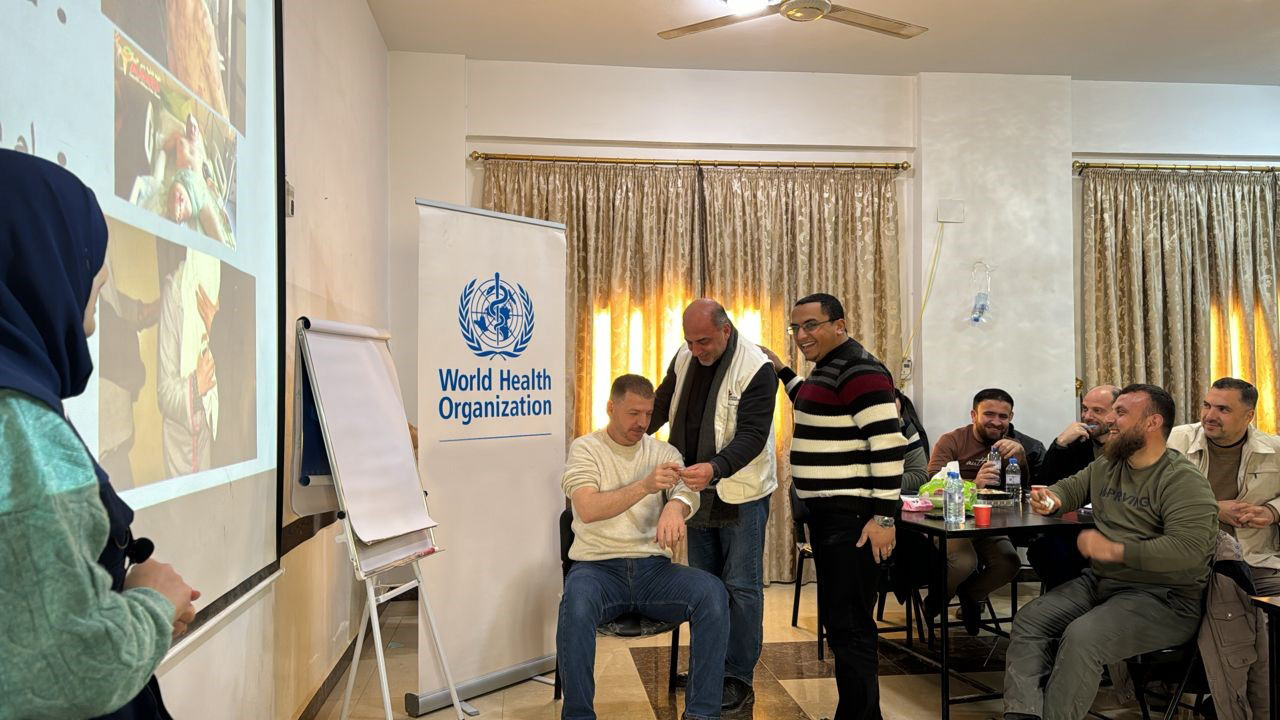 WHO staff facilitate training on burn care management in Atmeh, Idlib, north-west Syria. Photo credit: WHO Field Presence Office in Gaziantep, Türkiye 1 May 2024 – In north-west Syria, 2 million people (41% of the population) are living in about 1500 camps or self-settled sites. Housed in temporary shelters such as tents; they face an increased risk of burn injuries.
WHO staff facilitate training on burn care management in Atmeh, Idlib, north-west Syria. Photo credit: WHO Field Presence Office in Gaziantep, Türkiye 1 May 2024 – In north-west Syria, 2 million people (41% of the population) are living in about 1500 camps or self-settled sites. Housed in temporary shelters such as tents; they face an increased risk of burn injuries.
Burn injuries in north-west Syria are directly linked to poor and overcrowded living conditions, as well as the use of unsafe cooking and heating fuel. The risk of burns is even more significant in tents, which are highly flammable. A single domestic fire incident often causes multiple casualties, with the whole family suffering burns, especially children.
Yet the capacity to manage burn injuries remains critically low in north-west Syria.
The Atmeh burn care unit is the only referral burn centre in north-west Syria. In 2023, this centre provided care for 37 000 people and performed 2044 surgical procedures. More than 40% of these surgeries were for children aged under 5 years. These figures highlight not only the high number of burn injuries but also the growing need for specialized burn services in north-west Syria.
Managing burn injuries is medically complex and requires multiple medical interventions to ensure adequate treatment and care. It is futile to address just a single aspect of burn care in isolation without considering the full medical care package required.
In March 2024, WHO supported a one-day basic training and a 4-day advanced training in burn care in Atmeh, north-west Syria. In total, 54 interdisciplinary health care staff were enrolled in the trainings to enhance their knowledge and technical skills in specialized burn care. The training was developed and delivered by the WHO Field Presence Office in Gaziantep, Türkiye, with funding support from Norway.
“The training focused on all health staff involved in the management of burn patients. This allows for high-quality and holistic medical care. This will, in turn, help to reduce complications from burn injuries and improve the health outcomes of patients. Such an approach goes beyond the transfer of knowledge and addresses staff skills, attitudes and behaviour and the necessity of implementing best practices within the resource constraints,” explained Mr Raphael Veicht, Emergency Preparedness and Response focal point at the WHO Field Presence Office in Gaziantep.
“Considering the ever-increasing caseload of burn patients, especially with complicated burn wounds, this training was very important not only for me as a surgeon but for our entire hospital team. Such trainings are rare in north-west Syria, and we are really grateful for this opportunity,” said Dr Hassan, who took part in the advanced training.
The 4-day course included several practical exercises, plus theoretical knowledge on a broad range of topics such as nursing care, surgical management, nutrition, pain management, rehabilitation, and psychosocial support. Both trainings placed a continuous emphasis on the importance of the interdisciplinary management of burn patients.
“This training was special because the training took place within our hospital premises, providing hands-on training. Therefore, our entire hospital team could participate in the training,” added Ms Fathima, a nurse who joined in the training.




